Growing Cuban oregano (Plectranthus Amboinicus) at home can be a rewarding experience for the home gardener. This herb, also known as Spanish thyme or Cuban thyme, is a popular ingredient in Caribbean cuisine. Cuban oregano is easy to grow, drought tolerant, and can be grown indoors and outdoors. With its long-lasting, fragrant foliage and white flowers, Cuban oregano can make a great addition to any garden.
Growing Cuban oregano is a great way to bring a bit of the Caribbean into your backyard. This beginner’s guide will provide you with the information you need to get started on growing your own Cuban oregano. It will cover topics such as selecting suitable varieties, planting and harvesting tips, and how to care for your plant. With these simple steps, you’ll be able to enjoy the flavor and beauty of growing Cuban oregano in your home garden.
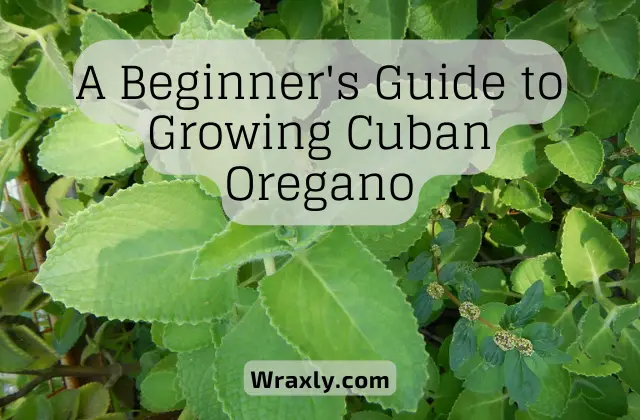
What Is Cuban Oregano?
Cuban Oregano (Plectranthus amboinicus) is an herb native to tropical regions of the Caribbean, South America, and Central America. It is a mint family member with a solid oregano-like aroma and flavor. The leaves are thick and fleshy, with a rough texture and rounded edges.
The stems are typically square and can be either single or multi-branched. When cooking a meal, chefs often use them as a seasoning for meats, soups, sauces, stews, and even salads. Also, many people often use Cuban oregano in Cuban and Latin American cuisine and herbal remedies.
Medicinally, Cuban oregano treats digestive issues, colds and flu, headaches, fever, and skin irritation. Many people also believe these plants have antiseptic and anti-inflammatory properties, which make these plants helpful in treating wounds and other skin ailments.
The Difference Between Cuban Oregano and Oregano
Cuban oregano (Plectranthus amboinicus) and oregano (Origanum vulgare) are two different species of plant that are often confused for one another due to their similar appearances and fragrant leaves. While both are members of the mint family and have a strong, aromatic smell, they have several key differences.
One of the most noticeable differences between Cuban oregano and oregano is its size; it tends to grow larger than oregano, with leaves up to 10 cm long. The texture of the leaves also differs; Cuban oregano leaves are fleshy and succulent, while oregano leaves are thin and papery. Additionally, Cuban oregano has a more intense, citrus-like flavor, while oregano has a more earthy flavor.
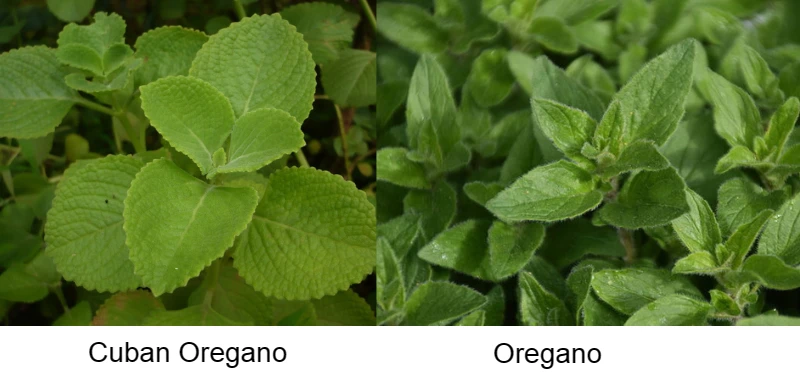
Cuban oregano and oregano also differ in terms of their uses in cooking. Cuban oregano is a common feature in Latin American cuisines as a substitute for cilantro and to season soups, stews, and beans. On the other hand, many people often use oregano in Mediterranean and Middle Eastern dishes. It is known for enhancing the flavor of tomatoes, pizza, and various types of meat.
Growing Cuban Oregano – Tips and Guides
Growing Cuban oregano is easy and rewarding, as it is an attractive addition to any garden. With a few simple tips, anyone can learn how to cultivate this unique herb and enjoy its many benefits.
This guide will find helpful information on how to get started, what type of soil is best for growing Cuban oregano, and how to care for it to ensure it grows strong and healthy. Whether a beginner or an experienced gardener, this guide will provide the information you need to grow this flavorful herb.
Choosing the Right Soil and Potting Mix
There are numerous soil types and potting mixes to choose when growing Cuban oregano. The type of soil and potting mix you choose will depend on various factors, including the climate where you live and the type of herb you plan to grow.
The quality of your soil and potting mix is directly related to the health and yield of your plants. The best soil for growing Cuban oregano is sandy loam, high in organic material and compost.
The ideal soil pH for growing Cuban oregano is between 6.0 and 6.5. If your soil is too acidic, you can increase the pH by adding peat moss to your soil or soil-less potting mix. If your soil is too alkaline, you can decrease the pH by adding coffee grounds to your soil or potting mix.
You may also be interested in… Everything You Need to Know About Laurel Leaves
When choosing a potting mix to grow Cuban oregano, it’s best to go with a soil-less mix. This allows you to control the pH level and provides your Cuban oregano with the perfect growing environment.
Recommended Potting Mix for Growing Herbs
| Image | Title | Prime | Buy |
|---|---|---|---|
 | Professional Indoor Herb Plant Soil | Large 2.2 Quarts Ready to Use for Kitchen Herbs, Gardens, Cooking Herbs | Peat Moss, Coco Coir, Perlite, Dolomite | Made in USA | PrimeEligible | Check My Price on Amazon |
Top | Soil Mixture for Indoor Herb Planters, Specially Blended Soil Mixture for Planting and Growing Indoor Kitchen Herbs Indoors, Indoor Herb Garden, Herb Growing Soil Mixture 8QT | PrimeEligible | Check My Price on Amazon |
 | Doter Organic Potting Soil Mix for All Indoor & Outdoor Small Containers Including Herbs, Vegetables, and Flowers 1 qt | PrimeEligible | Check My Price on Amazon |
 | Espoma Organic Potting Soil Mix - All Natural Potting Mix For All Indoor & Outdoor Containers Including Herbs & Vegetables. For Organic Gardening, 4qt. bag. Pack of 1 | PrimeEligible | Check My Price on Amazon |
 | Organic Harvest Potting Mix Soil for Vegetables, Herbs and Flowers, 4 Quart (Packaging May Vary) (1 Bag) | PrimeEligible | Check My Price on Amazon |
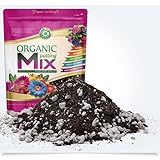 | Organic Potting Soil & Planting Mix for All Indoor and Outdoor Plants. Made in USA Special Formula for Holistic Herbs & Spices, Fruit, Vegetables, and Flowers. Germinate Seeds, Cuttings, and More! | PrimeEligible | Check My Price on Amazon |
Planting Your Cuban Oregano
If you are growing Cuban oregano from seed, you should start your seeds indoors 4 to 6 weeks before the last frost date in your area. You can also purchase seedlings to speed up the growing process.
Cuban oregano is an herb that grows well in containers. However, if you use containers, ensure they have ample drainage holes. Choose a sunny location to grow your plants so Cuban oregano can stay warm.
You can mix your Cuban oregano seeds with some potting soil to help them germinate. Once your Cuban oregano seeds have germinated, gently remove them from the soil and plant them in your containers or garden bed.
Cuban oregano can be grown as an annual, perennial, or indoor herb. If you are growing Cuban oregano as an annual, it is best to plant your seeds after the last frost date in your area. If you are growing Cuban oregano as a perennial, you can plant your seeds as early as you can work the soil.
Recommended Cuban Oregano Plants
| Image | Title | Prime | Buy |
|---|---|---|---|
 | 2 Cuban Oregano plants | Prime | Check My Price on Amazon |
Top | Cuban Oregano, (2 Live Plant) Indian Borage, Mexican Mint, Spanish Thyme | Prime | Check My Price on Amazon |
 | Variegated Cuban Oregano Live Plant Rooted 5 to 7 Inches Ready to Grow Pot | Prime | Check My Price on Amazon |
 | Cuban Oregano Seeds,AKA (Broad Leaf Thyme) Spanish thyme,Mexican Mint,Hung chanh | Prime | Check My Price on Amazon |
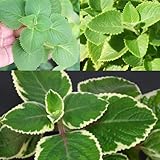 | 3 Cuban Oregano Plants Live Mexican Mint Spanish Herb Vegetables Well Rooted Mixed Combo 2 Green + 1 Variegated Cuban Oregano | Prime | Check My Price on Amazon |
 | Cuban Oregano Seeds | Prime | Check My Price on Amazon |
 | Broad Leaf Thyme AKA Cuban Oregano, Spanish thyme, Mexican thyme | Prime | Check My Price on Amazon |
Caring for Your Cuban Oregano
Like most herbs, Cuban oregano does not require much maintenance. In fact, too much attention can be harmful to your Cuban oregano plants. Cuban oregano thrives in warm soil with plenty of sun. If you are growing Cuban oregano indoors, keep your herb pots in a sunny location.
Water Cuban oregano plants once a week, as this is usually plenty to keep them on the dry side. It would be best if you water your Cuban oregano plants when the soil feels dry. However, over-watering your Cuban oregano plants can cause root rot.
You can fertilize your Cuban oregano plants once a month with a general-purpose fertilizer. Cuban oregano plants do not require a lot of attention, so you can spend your time enjoying the fruits of your labor. When harvesting your Cuban oregano, you should always leave at least one pair of leaves on the plant. This will help promote new growth and prevent your Cuban oregano plants from dying.
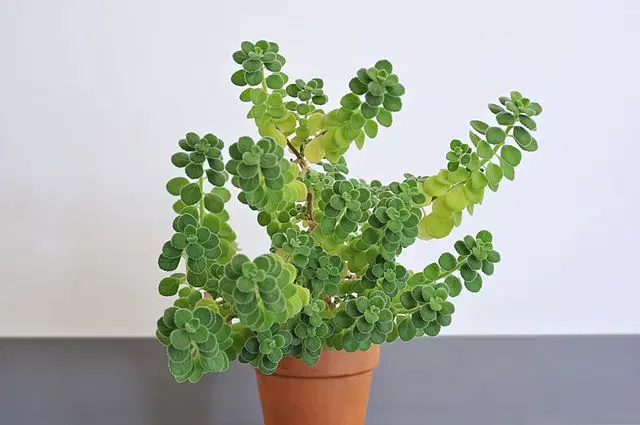
Harvesting Your Cuban Oregano
The ideal time to harvest Cuban oregano is when the plants measure between 10 and 12 inches. Another sign is that the plants start to blossom when the leaves have grown to their full size. But, if you cultivate Cuban oregano yearly, you can start gathering the plants as soon as the flowers appear.
When the blooms begin to brown, it indicates that it is growing as a perennial, so you can begin harvesting it. You can easily collect the Cuban oregano by cutting the plant at its base. Maintaining at least one pair of leaves on your Cuban oregano plants will help them continue to flourish.
There are several methods you may use to keep your Cuban oregano in storage. You can dry it out by suspending it in a well-ventilated space, wrapping it up in a paper towel, and putting it somewhere dark and dry.
Cuban Oregano Common Issues
One of the most common issues is over-watering. Cuban oregano prefers drier conditions, so if you overwater it, the roots will rot, and the plant will die. Another issue is a lack of light. Cuban oregano needs plenty of indirect sunlight, so make sure the plant is in a sunny spot.
Cuban oregano needs well-draining soil. If the soil is too compact, there won’t be enough oxygen for the roots, and the plant can suffer. To avoid these issues, follow the proper growing guidelines for Cuban oregano. With patience and care, you can enjoy fresh, homegrown oregano in your cooking!
Some of the common problems in Cuban oregano plants are:
- Yellow tint: you may have over-watered your Cuban oregano plants.
- Leaves are curling or turning black: You may have underwatered your Cuban oregano plants.
- Wilted and limp leaves: you may have an issue with your soil pH level.
- Black spots on leaves: You may be experiencing Cuban oregano thrips if there are small-sized bugs or black holes on the leaves.
- Sticky substance on the leaves: You may have Cuban oregano aphids.
- Wilted or yellow leaves at your plants’ bottom: You may suffer from Cuban oregano root rot if you see wilted or yellow leaves at your plants’ bottom.
Benefits of Consuming Cuban Oregano
Cuban oregano is an excellent source of vitamins A, B, and C, and it also contains minerals such as iron, magnesium, potassium, and zinc. These nutrients impart many health benefits, from boosting the immune system and heart health to improving digestion and fighting bacteria.
Here are a few benefits of Cuban oregano you’ll want to keep in mind when cooking with it.
Antibacterial and Immune Building Properties
The essential oils found in Cuban oregano make it a natural antibacterial agent. In addition, the herb also has anti-inflammatory properties that help combat the effects of aging and improve immune system response. Studies have shown that Cuban oregano has the potential to fight bacteria that causes common illnesses such as food poisoning, MRSA, E. coli, and Staphylococcus. You can even use it to fight the antibiotic-resistant bacteria that have become a public health threat.
Better Heart Health
The high antioxidants and flavonoids in Cuban oregano make it a powerful addition to the diet. Studies have shown that these compounds help lower the risk of coronary artery disease and high blood pressure, two major causes of death in the United States. Cuban oregano may also help manage diabetes, and it can help prevent blood clots and strokes.
Detox Benefits
Cuban oregano’s high levels of essential oils make it a powerful detoxification agent. Studies have shown that these compounds help remove heavy metals and other toxins from the body. Cuban oregano may also have a positive effect on the liver and can help with the removal of excess cholesterol.
Improve Bone Health and Blood Circulation
The high calcium levels in Cuban oregano make it a natural source of bone-building nutrients. The herb can also help prevent bone loss, making it an excellent addition to the diet of older individuals. In addition to calcium, Cuban oregano is a rich source of iron, essential for red blood cell production. Iron deficiency is common among older adults, particularly women, and iron-rich foods like Cuban oregano can help improve their quality of life.
Healing Booster
One of the essential benefits of Cuban oregano is its ability to boost healing. The herb has antibacterial and anti-fungal properties that can help fight infections on the skin and inside the body. It may also help manage symptoms of gastrointestinal disorders, including irritable bowel syndrome.
Repel Mosquitoes
Cuban oregano is also potent as a pest repellent, particularly against mosquitoes. Studies have shown that compounds in Cuban oregano can effectively repel mosquitoes for short periods. One study found that the leaves of Cuban oregano, from which people can extract the essential oil, protects people from mosquitoes for up to two hours.

Helps Manage Fever
Recent studies have shown that extracts from the Cuban oregano plant can help reduce body temperature and other fever-related symptoms. This is due to compounds called phytonutrients, which have anti-inflammatory properties. The leaves and stems of the Cuban oregano plant can be boiled and ingested as a tea, or the leaves can be crushed to make a paste and applied directly to the skin.
Cuban Oregano Pork Tenderloin Recipe
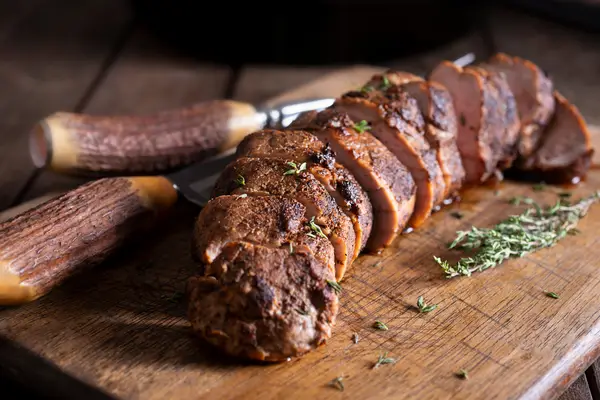
Making a Cuban oregano pork tenderloin is a delicious and easy recipe that will impress your family and friends. The key to making this dish is using the right ingredients and properly seasoning the pork.
First, you’ll need to gather the ingredients:
- 2 tablespoons of olive oil
- 1 teaspoon of smoked paprika
- 2 teaspoons of dried oregano
- 1 teaspoon of cumin
- 2 cloves of garlic, minced
- 1/2 teaspoon of salt
- 2 lbs. of pork tenderloin
Once you’ve gathered your ingredients, it’s time to prepare the pork. Begin by heating the olive oil in a large skillet over medium heat. Add the garlic and cook for about 1 minute, stirring frequently. Then add the oregano, cumin, smoked paprika, and salt, and stir to combine.
Next, add the pork tenderloin to the skillet and turn to coat with the spice mixture. Cook for about 5 minutes, flipping the pork halfway through until it’s lightly browned on the outside and cooked through.
Remove the pork from the skillet and let it rest for about 5 minutes before slicing it into thin slices. Enjoy it! Serve with a side of rice and beans for a delicious and authentic Cuban meal.
How to Make Cuban Oregano Tea?
Making Cuban oregano tea is an easy and delicious way to enjoy the many health benefits of this herb. To make Cuban oregano tea, you will need the following:
- 2 teaspoons of dried Cuban oregano leaves
- 2 cups of boiling water
Instructions:
1. Place the two teaspoons of dried Cuban oregano leaves in a teapot or mug
2. Pour the boiling water over the leaves and steep for 5 minutes
3. Strain the tea and discard the leaves
4. Enjoy your Cuban oregano tea
Cuban oregano tea is a great way to help reduce inflammation and boost your immune system. You can also drink it as a natural remedy for colds and flu. Enjoy your Cuban oregano tea hot or cold, sweetened with honey or unsweetened.
What Does Cuban Oregano Taste Like?
Cuban oregano has a unique flavor that we can describe as a combination of lemon and sage. Its taste is spicy and earthy, with a hint of sweetness. The leaves have a robust and aromatic aroma; people commonly use them to flavor stews, soups, and sauces.
People commonly use Cuban oregano in traditional Cuban dishes such as ropa vieja and sofrito. It is an essential ingredient in mojo marinade, a marinade used to season meats. In addition, its antiseptic properties make Cuban oregano effective in treating colds and other respiratory illnesses.
Final Thoughts on Growing Cuban Oregano
You may consume oregano in a variety of ways for health advantages. You can also use them in cooking and as an herb in any dish. Cuban oregano is also an easy-to-grow herb that adds benefits to any home garden. Growing Cuban oregano is easy, provided you have the right growing conditions. If you follow these tips, you’ll be well on your way to growing a successful Cuban oregano plant in your home garden.
You May Also Be Interested In… A Beginner’s Guide to Growing Stevia

Darrell has a passion for gardening that he inherited from his father. Go here to read more about the influence his father played in his love for gardening. If you want to send Darrell a quick message, then visit his contact page here.

![How to Water Indoor Plants [Plant Care 101]](https://wraxly.com/wp-content/uploads/2021/03/How-to-Water-Indoor-Plants-Plant-Care-101-1200-1024x576.webp)

![Growing Plants from Cuttings [A Simple Guide]](https://wraxly.com/wp-content/uploads/2021/03/Growing-Plants-from-Cuttings-A-Simple-Guide-1200-1024x576.webp)